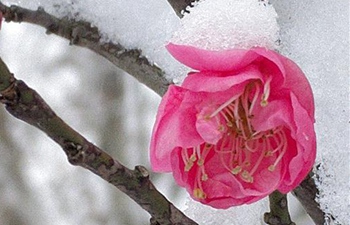CHICAGO, Jan. 31 (Xinhua) -- There is a distinct regional pattern in China's 30,000 flowering plant species: Eastern China is a floral "museum" with a rich array of ancient lineages and distant relatives, while the western provinces are a "cradle" for newer and more closely related species.
In a study published Wednesday in the online edition of Nature, researchers from the Chinese Academy of Sciences, Hope College, the Florida Museum of Natural History, and the University of Michigan (UM) highlight the need for more conservation efforts in densely populated eastern China, home to many threatened plant species.
In the study, researchers produced the first dated phylogeny, a family tree of organisms showing when new species appeared, for all of China's flowering plant species, or angiosperms, and mapped their distributions using 1.4 million museum records.
The researchers found that about 66 percent of angiosperm genera in China did not originate until the early Miocene, about 23 million years ago. Mean species divergence times when species first appeared fell between 22-25 million years ago in the East and 15-19 million years ago in the West.
Over the past 30 million years, herbaceous plants, those without a woody stem, diversified much more quickly than woody genera such as shrubs, trees and vines.
China is home to about 10 percent of the world's flowering plant species, outstripping the number of angiosperm species in the U.S. by more than 3.5-fold. Its varied geography and climate contribute to its wealth of biodiversity.
Unlike North America and Europe, China did not undergo the dramatic ecological turnover driven by glaciation in the ice age from about 2.58 million to 11,700 years ago, thus allowing ancient plant lineages to persist in the East and newer lineages to be folded into ever-diversifying plant communities.
China didn't experience that big type of cataclysmic event, and that allowed it to be more of a museum than other parts of the Northen Hemisphere, said Doug Soltis, professor and curator at the Florida Museum of Natural History.
The uplift of the Qinghai-Tibetan Plateau in the West spurred the region's evolutionary explosion of new species by opening up myriad new habitats and creating a cool, arid western climate. The West became a cradle for newer herbaceous plants while the East remained a museum for older herbaceous plants and both a museum and a cradle for woody plants.
The researchers used species-distribution data to map China's areas of genetic richness, pinpointing several eastern provinces as home to the country's greatest genetic diversity of flowering plants: Guangdong, Guanxi, Guizhou, Hainan and Yunnan. Conservation in the East, however, is carried out on a much smaller, more fragmented scale than in the sparsely populated West.
The researchers pointed to the value of museum collections in enabling this country-scale study of thousands of plant species spanning millions of years of evolution. Each plant specimen, painstakingly collected and preserved in herbaria over the past century and digitized, contributed to an enormous dataset that offered a detailed snapshot of China's diversity of flowering plants.
"It is only the beginning, as we can now apply these methods across the globe and throughout the tree of life," said Stephen Smith, a UM evolutionary biologist and co-author of the study.

















